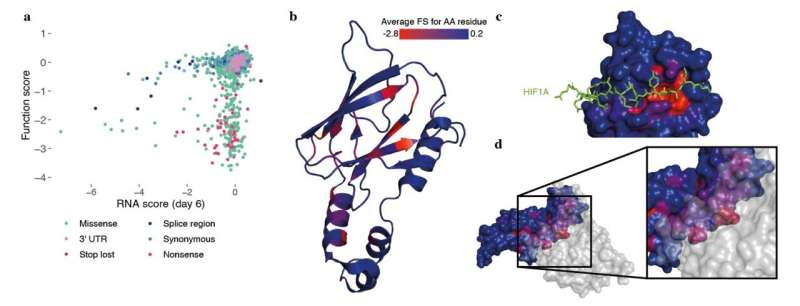This article has been reviewed according to Science X's editorial process and policies. Editors have highlighted the following attributes while ensuring the content's credibility:
fact-checked
peer-reviewed publication
trusted source
proofread
Researchers map the effects of all potential changes in key cancer gene

Researchers at the Francis Crick Institute have mapped all the possible outcomes of changes to a tumor-suppressing gene called VHL, the first step in a huge research endeavor to unpick the outcomes of tens of thousands of genetic variations in genes associated with cancer.
This VHL map could help clinicians work out which patients are at risk of developing kidney cancer or might respond to certain drugs.
Genetic changes or variants happen when one or more building blocks in DNA are altered. Both acquired and inherited variants in the VHL gene can increase the risk of kidney cancer. But many people are diagnosed with 'variants of unknown significance' in VHL and don't know what this means for their cancer risk.
In research published today in Nature Genetics, researchers at the Crick used a new method called saturation genome editing to track the function of over 2,000 different VHL variants in human cells over time.
They measured how many cells survived with each VHL variant, which was then given a "function score": the lower the score, the more harmful the variant.
Most of the VHL variants analyzed did not impact the survival of the cells, suggesting that people with these variants may not have a significantly higher risk. However, other variants were shown to be faulty for the first time, meaning patients with these variants may now be offered regular screening to reduce their cancer risk.
The most harmful variants caused the cells to die. The team found that the faulty VHL gene increased the activity of another gene called HIF. This gene is needed to help cells survive in low oxygen, but too much HIF protein can cause tumors.
Removing HIF from cells with these VHL mutations kept the cells alive, showing that the negative effects of VHL are dependent on HIF.
Belzutifan, a drug that inhibits the HIF protein, only works for people with mutations impacting the amount of HIF present in cells. The scoring system developed by the Crick team could identify people with VHL mutations who would benefit from belzutifan treatment.
Finally, the researchers compared their scoring system with publicly available databases on kidney cancer, finding that their method could predict cancer-causing variants previously identified in the clinic with 100% accuracy.
Greg Findlay, Group Leader of the Genome Function Laboratory at the Crick, said, "Lots of people are told they have a 'variant of unknown significance' in the VHL gene and they're in the dark about what that means for their cancer risk. Our variant function score could be a clinically useful test to categorize patients.
"In fact, we show that patients with the lowest scoring VHL variants tend to get kidney cancer at the highest rate. We are now working to apply this method to more genes to bring this level of diagnostic precision to more people."
Megan Buckley, first author and current Ph.D. student at the University of Cambridge, said, "By fine-tuning the saturation genome editing method, we've shown that a relatively simple test can identify what different VHL mutations do in human cells.
"Surprisingly, lots of variants potentially linked to cancer had neutral scores in this test, suggesting that the scoring system could bring clarity to patients in limbo about what their VHL diagnosis means."
The lab is now working with the Cancer Dynamics Laboratory at the Crick to track how well the function score can predict tumor growth and response to treatment in patients with VHL mutations. They are also working with the Wellcome Sanger Institute and The Institute of Cancer Research, London to map all variant effects across 15 other cancer risk genes.
More information: Megan Buckley et al. Saturation genome editing maps the functional spectrum of pathogenic VHL alleles., Nature Genetics (2024). DOI: 10.1038/s41588-024-01800-z. www.nature.com/articles/s41588-024-01800-z. On bioRxiv: DOI: 10.1101/2023.06.10.542698



















